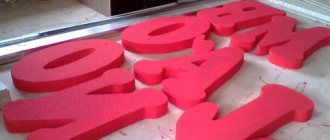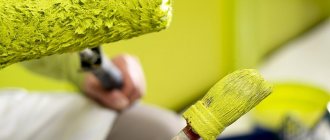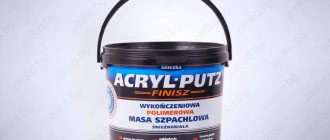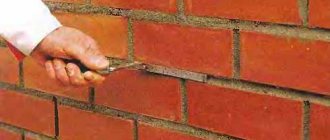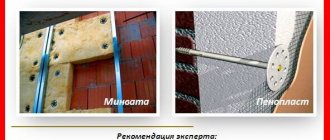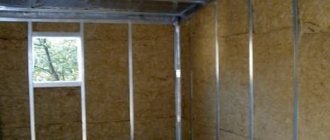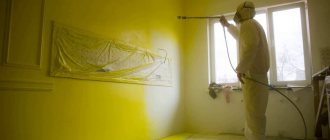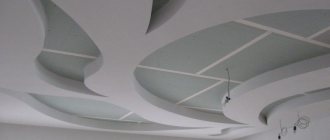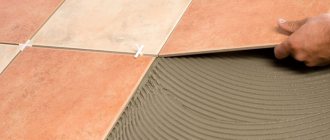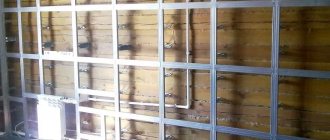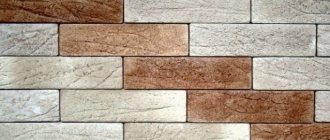Prepare your sleigh in the summer... This proverb perfectly reflects the fact that it is never too late to think about insulating your home, or rather, it is better in advance.
According to reviews, among the types of insulation of both private houses, dachas and cottages, and multi-storey (apartment) buildings, external insulation is the leader. And among the materials, the absolute favorite is polystyrene foam.
We propose to understand what determines the high efficiency of insulating walls with foam plastic from the outside.
Overview of the material
Before insulating a house with polystyrene foam, you need to find out which material is suitable for which structures. EPS is supplied to the trading floors of the construction market in the form of slabs of different densities and in bulk. Each option belongs to the group of polymers with a foamed structure.
The table presents a number of basic technical characteristics characteristic of the group of foam materials for home insulation.
| Parameter | Meaning | What is important for a builder |
| Density | 15-40 kg/cub.m | The low weight of a cubic meter of insulation is considered one of the main advantages. This is justified by the relatively insignificant load of the material on the load-bearing structures of the building, which practically does not limit the scope of application of PPS. |
| Thermal conductivity | 0.038-0.042 W/m*K | The values are close to the average compared to thermal insulation products, which are often used in construction. |
| Water absorption | 0,02 | Extruded polystyrene foam has an indicator as close as possible to zero. This justifies the use of the material as an independent and additional waterproofing layer. |
| Vapor permeability | 0,05 | A low coefficient indicates poor breathability of PPP. This property is important to take into account especially during interior work, as it affects the microclimate in the room. |
| Working temperature | -50-+75 degrees Celsius | Foams are synthetic in nature, so when heated they can release toxic substances. Therefore, insulation is rarely used indoors with high thermometer readings. |
| Operational period | 60 years (outside 20 to 40 years) | The time period can be reduced if the rules for installation and operation of materials are not followed. |
Extruded foam Source myremontnow.ru
Experts recommend paying attention to the chemical composition before purchasing polystyrene foam for insulation. It is desirable that it contains fire retardant additives and non-flammable carbon dioxide. This is justified by the fact that PPS is unstable to open fire. When purposefully igniting foam plastic, the effect of fire retardants may not be noticed, but in general, thanks to them, the fire takes longer.
The advantages of the material, in addition to good thermal insulation properties and water resistance, include noise absorption and inertness to corrosion and biological activity. Foam boards and granules are often used to improve the acoustic environment in a building. The material is also easy to cut, which is important for installation work. But it is worth considering that foamed polystyrene can crumble and cannot withstand mechanical load and is deformed.
PPP and dew point
Insulation tends to shift the dew point outward. Let's consider three design options without insulation and with insulation with polystyrene foam. In the absence of finishing, the walls are the only material that is located between spaces of different temperatures. Due to changes in thermometer readings, the following occurs:
- heat loss;
- condensation indoors;
- the operational life of the monolith or log house is reduced.
If the dew point in a log house without finishing is poorly calculated, then there is a possibility of condensation Source remontnik.ru
See also: Catalog of companies that specialize in insulating houses
When insulating walls internally, the dew point shifts towards the contact between the base and the PPS. Heat leakage is significantly reduced, but the issue of dampness remains. Because of this, there is an increased risk of the appearance and spread of mold, mildew, and bacteria.
The optimal solution is to insulate external walls with polystyrene foam. In this case, the dew point is closer to the surface on the front side of the structures. As a result, the risks of heat loss and condensation accumulation are minimized.
Is vapor barrier and waterproofing necessary?
Polystyrene foam is a material that has fairly good resistance to the passage of vapors. When insulating walls made of block materials or brick, there is no need to install vapor barrier membranes.
When insulating the facade of a wooden building, a vapor barrier membrane is needed. It is attached between the wall and the foam plastic so that a ventilation gap is formed.
Waterproofing is not installed under foam plastic.
IMPORTANT! If walls are insulated with foam plastic under siding, then a diffusion membrane is used, not a vapor barrier.
These two materials differ in their ability to pass vapors.
External insulation technology
You can insulate walls with foam plastic on your own, since the technology for installing lightweight insulation is simple and does not require special skills or tools. However, before starting work, it is important to learn about the features that are associated with facades, internal walls and openings for windows and doors. There are also some nuances in subsequent finishing.
Preparatory stage
Any installation and repair work begins with preparing the base. It must be clean, “healthy” and, in the case of slab foam, even. The procedure at this stage looks like this:
- removal of old decorative coating;
- removing weak elements;
Peeling pieces of plaster must be removed Source krysha-expert.ru
- bridging cracks;
- “treatment” of affected areas (mold, mildew, rust) followed by prevention;
- priming of defects and repairs;
- treating the working surface with a primer;
- leveling the walls (differences of up to 1 cm per linear meter are acceptable) and forming corners.
Before insulating the facade with polystyrene foam, it is recommended to impregnate the dry and even base twice with a primer. In this case, for the second layer it is permissible to dilute the primer with water. The main thing is not to exceed 10%, so as not to reduce the quality of the original product.
Installation work
As a rule, to insulate vertical structures, craftsmen use a slab version of PPS. There is no need for lathing here, but the fastening must be combined. That is, first a special adhesive solution is applied and the position of the canvases is adjusted to create an even plane. To prevent the insulation from slipping, you must first secure a support strip under the first row. This can be a beam or a metal profile. If you lay the first row unevenly, then subsequently all the joints will turn out to be uneven.
Then, after the composition has hardened (after about three days), additional fixation is carried out with plastic dowels (“umbrellas” or “fungi”) with a wide cap.
Special dowels for insulation Source allegroimg.com
Foam reinforcement on walls
Sometimes it happens that the work stretches over two seasons. At some stage the structure is left for the winter. This is done when the leveling layer is applied, otherwise the material will be damaged. Actions are performed in the following order during installation of reinforcing mesh :
- Use a spatula with a minimum width of 350 mm. With this tool, the surface is covered with universal-purpose glue. The width of the strip of material is 5-7 cm less when compared with the mesh. As a standard, nets are produced with a width of 100 cm.
- Next comes rolling the mesh up and down. 5-7 cm on one edge remain free from glue.
- Passing a spatula along the mesh and pressing the material into the glue. The smoother the surface, the better.
- An empty grid is the place to start working with the second strip of material. The reinforcement is done anew, close to the material that is already on the surface. The result is two layers of mesh at certain joints. The thickness of the glue is the same as everywhere else.
When the mesh is glued, it is left until everything is dry. The minimum time is 12 hours, but it is better to wait a day. A grater with emery helps to level all surfaces.
Foam plastic plaster: applying a leveling layer
In this case, the application technique remains standard if the mixture is used to form a protective layer . The choice of glue thickness for a particular case is determined by the results left from the previous stage. The leveling finishing layer can be very thin if everything was applied smoothly before. But the mixture should be slightly liquid. This consistency makes leveling easier.
Figure 5. Applying the mixture to form a protective layer.
The leveling layer must be left for some time until it dries. The temperature and thickness of the material determine how long it takes.
External facade finishing
There are three methods for external wall cladding:
- Hanging siding panels.
- Laying varieties of facing bricks.
- Plaster. It can be painted later, but an option without paint is also acceptable.
PPS or EPPS
The starting raw material for the materials is polystyrene. The final product can vary greatly in density, hardness and structure. This is explained by the plate production technology:
- Foaming . Expanded polystyrene is characterized by lower weight due to the high air content in the pores and granules. The advantage is the low price, the disadvantage is that it retains heat worse with the same thickness of the slab.
- Extrusion . EPPS has less moisture-absorbing ability and higher density, strength and hardness. With identical sheet thickness, the thermal conductivity is lower. Against the background of the advantages, only one disadvantage stands out in the group of materials - high cost.
Craftsmen also note the low adhesion of extruded insulation due to the dense and smooth surface. To improve the situation, the boards are passed with a float or a needle roller (with metal spikes) to bend the drywall. Also, such products are characterized by a stepped shape of the mounting edges. This is a practical approach from manufacturers, thanks to which there are no cold bridges and the joints between individual sheets are strengthened.
Production line for extruded polystyrene foam Source ros-tenders.ru
Preparation
Before you begin installing foam plastic on the outer surface of the facade, you need to prepare the walls of the building.
For easy ascent to the third or second floor, build or order scaffolding on the Internet - a temporary auxiliary structure made of wood (boards are knocked together) or metal structures.
This also has its own subtleties: scaffolding cannot be placed close to the wall - be sure to leave a distance to the wall of at least 60 cm (this includes the width of the foam).
The next step is to check the walls for unevenness or defects.
Clean the cinder block or aerated concrete blocks from dirt (depending on what the house is built from), and cover any damage, holes or cracks with cement mortar. Drill the necessary holes for wires or pipes.
Facade system
If the house is made of aerated concrete, sand-lime brick or foam block, then additional treatment of the walls with a soil solution is required - 2 times instead of 1.
Dilute the deep penetration primer with water (add a third or half of the volume) and treat the walls only in those places that require it. You should not waste the solution over the entire area if the walls are perfectly flat and smooth, however, this is rare.
Application of polystyrene foam
Briefly about the main thing
Foam plastic is actively used as insulation for walls due to its lightness, low thermal conductivity and relatively low cost.
The technology for installing PPS and EPS boards includes preliminary leveling of the working base, gluing the sheets and then fixing them on special dowels. If necessary, the joints are filled with low-expansion polyurethane foam.
It is considered more practical to use two-layer insulation with overlapping seams of the previous one. The slabs are shifted to the side in a row.
Before painting, it is enough to prime the finished coating after filling the voids and recesses from the fasteners.
Before plastering and cladding, polystyrene foam is reinforced with fiberglass mesh, which is attached to a special adhesive for polymer materials.
The ventilation facade is made with a layer of waterproofing membrane.
Ratings 0
Versatility
If we consider the pros and cons of foam insulation, then the versatility of its use must be mentioned as advantages.
Polystyrene foam is used for insulation:
- Sten;
- Roofs;
- Paul;
- Base;
- Residential and industrial buildings.
The use of this material is a classic method of insulation. Therefore, this material will help make the house warm and comfortable. In addition, if the main stages of work are carried out correctly, the result is quite durable and reliable, and the materials and work are inexpensive.
With proper use, polystyrene foam under plaster will last quite a long time without changing its qualities. Sheets are used to insulate walls, crumbs or balls are used for the roof, and extruded polystyrene foam is used for the floor or base.
Video instructions:
Other benefits:
- Polystyrene foam is one of the easiest materials to work with;
- It is very pliable, so it can be cut with a hacksaw or knife;
- In addition, you can easily make a hole in it of any size and depth. This property is useful when it is necessary to insulate surfaces with protruding cornices, windows or decorative elements;
- Lightweight foam can be glued to any surface, and after the glue has dried, it can be further processed.
But do not forget that there are also disadvantages of such insulation, which should be taken into account when making a decision.
Do-it-yourself insulation of external walls with polystyrene foam: advantages and disadvantages
Expanded polystyrene insulation is a good solution if you plan to insulate the facade of your house yourself, because it:
- Available in slabs that are lightweight. Even 1 person can lift them and easily move them to the right place. He will not need assistants for this.
- It is characterized by a simple processing process. Expanded polystyrene is easy to cut.
- It just attaches. The installation work can be carried out by 1 person.
It is worth choosing polystyrene foam, because it will perfectly retain heat in your home.
This material will not be exposed to moisture; it is not at all afraid of it. Residents of the house will not need to worry about the environmental safety of the material. Today, such a heat insulator is produced using technologies that prevent it from emitting any harmful substances. For the same reason, you will not need to use special equipment when working with it. If we insulate the outside of the house with expanded polystyrene, then we need to be aware of the disadvantages of such a heat insulator. This material is inferior to the same mineral wool in its fire safety properties. It is known that it contains special additives that slow down the combustion process. But their effect is short-lived. If you follow fire safety rules during the construction and further operation of the building, then you don’t have to pay special attention to this drawback.
Required thickness of thermal insulation
To correctly select the thickness of the foam, it is necessary to take into account the weather conditions of the environment, as well as the building material that was used as the main one in the construction of the structure.
Depending on the wall material, the recommendations of experts are as follows:
- brick house - from 5 centimeters and more (optimally - 7 centimeters);
- concrete - from 5 centimeters of grade PSB-35;
- wooden - from 7 centimeters, insulation of a wooden house must be carried out with a membrane mesh;
- for logs - from 7 centimeters, it is recommended to level the base;
- frame houses - from 5 centimeters, it is advisable to also insulate from the inside by laying thermal insulation material under the sheathing.
The presented figures are relevant for the use of façade-type PPS with a density of 25-35 kilograms.
Advice from experts
If only one wall begins to freeze, it is still worth installing insulation around the perimeter.
It is better to insulate windows and doors immediately after their installation, and insulate walls after 1-2 years.
It wouldn’t hurt to leave ventilation gaps between the foam and the wall. They should be small. When building a house, it is better to immediately think about the ventilation system.
You should not stop only at insulating the walls, since a significant portion of the heat can escape into the atmosphere through the ceiling and floor.
Recommended viewing:
Returning to the question of the possibility of insulating a wooden house with polystyrene foam, we can conclude that this is quite acceptable. The main thing is to do all the work correctly, in compliance with fire safety requirements.
